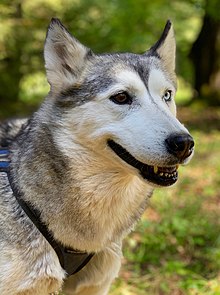Siberian Husky
| Siberian Husky | ||
|---|---|---|
|
|
||
| FCI Standard No. 270 | ||
|
||
| Origin : | ||
| Withers height: |
Male: 53.5-60 cm (21-23.5 inches ) |
|
| Weight: |
Male: 20.5–28 kg (45–60 lbs ) |
|
| List of domestic dogs | ||
The Siberian Husky is an FCI recognized dog breed ( Group 5, Section 1, Standard No. 270 ) from the USA .
Origin and history
The ancestors of the Siberian Husky come from northern Siberia. For centuries they were indispensable companions of the nomadic peoples living there, for example the Chukchi or the Yakuts .
In 1909, the fur trader William Goosak , who came from Siberia, registered with his small, relatively petite dogs for the All-Alaska Sweepstakes - dog sled race (408 miles from Nome to Candle and back). He was laughed at because of his "little dogs". Goosak finished third in this demanding race. The following year John Johnson ("Iron Man") won with dogs that were just as small. The other two registered teams of “Siberian Huskies” took second and fourth place. As a result, the breed was founded in Alaska in 1910 by the Norwegian musher Leonard Seppala . Seppala's male Togo , among others, played an important role in the development of the breed .
description
The most important features of the appearance are according to the breed standard : the males grow up to 60 cm and the bitches up to 56 cm. The weight of adult males is up to 28 kg and that of females up to 23 kg. The structure of the body should be essentially rectangular, the height of the trunk should be in good proportion to the length. The most important thing when assessing the body structure is the suitability of the husky for pulling work. The coat of the Siberian Husky consists of two layers: the undercoat and medium-length top coat. While the undercoat, which is changed once or twice a year, is pure white or only slightly colored, the top coat can take on all colors from white to red and gray to black. The most common mark on the body is a strong color on the back, which becomes weaker and weaker over the sides towards the stomach. The drawing of pinto (piebald fur) is rarely seen. The abdomen and chest are usually pure white.
The skull tapers slightly towards the eyes and has a pronounced stop. Overall, it should not make an impression that is too bulky. The muzzle tapers slightly towards the nose without looking pointed. The ears are medium in size, triangular, close together and set high. They are thick and well haired. The nose is adapted to the color of the coat, liver-colored in red, black in black and gray dogs. A not completely pronounced pigmentation (so-called snow nose) is not a breeding defect. The eyes can be blue, brown, or amber. The appearance of differently colored or mixed colored eyes also corresponds to the breed standard. Often one eye is brown, the other blue ( odd-eyed ). The head fur is often strikingly drawn in the form of an open or closed mask. According to the standard, the Siberian Husky has a sickle rod that should never be carried rolled over the body. The bushy tail of the husky is equipped with particularly stiff stick hair and contains no (or only little) undercoat . This enables the husky to be completely snowed in in a blizzard by curling up and sticking its nose under its tail. This acts as an air filter and air preheating so that the husky can spend the night under the snow.
The husky is optimally adapted to the polar regions. Its fur has two layers: the top hair, which is water-repellent and robust, and the undercoat , which consists of fine hair. The two layers form optimal thermal insulation , because the undercoat generates heat (friction) when the dog moves, and the top hair prevents heat loss. The husky's paws are comparatively smaller and more compact than those of dogs of similar size. This counteracts the loss of heat here too, and the risk of injury is reduced.
use
The husky is able (with sufficient training) to pull nine times its own body weight and has thus become a vital livestock and family member of the Eskimos . Puppies are raised together with their own children in the house, which creates the huskies' human and child-friendly characteristics. They also had to obey everyone because the sleds weren't driven by just one man. So only the most obedient and friendliest dogs were used for breeding. Huskies have an excellent sense of direction , thanks to which they never stray from familiar paths, even if they are no longer visible due to the thick blanket of snow.
character
The FCI describes the husky as follows: The characteristic temperament of the Siberian Husky is friendly and gentle, but also attentive and sociable. He is not a watchdog and is rarely suspicious of strangers or other dogs. He is said to be intelligent and easy to direct and is such a good companion and willing working dog.
Diseases typical of the breed
Huskies are prone to a presumably genetic skin disease, zinc-reactive dermatosis . The cause is a reduced absorption of the trace element zinc from food.
Individual evidence
- ↑ Behavior / character (nature) In: FCI-Rassestandard Siberian Husky.


